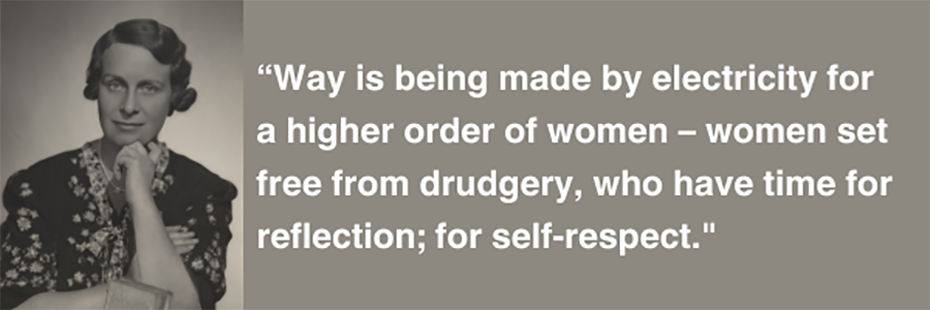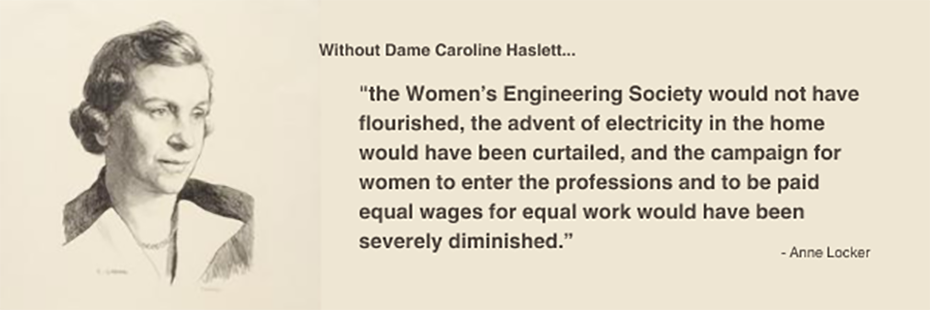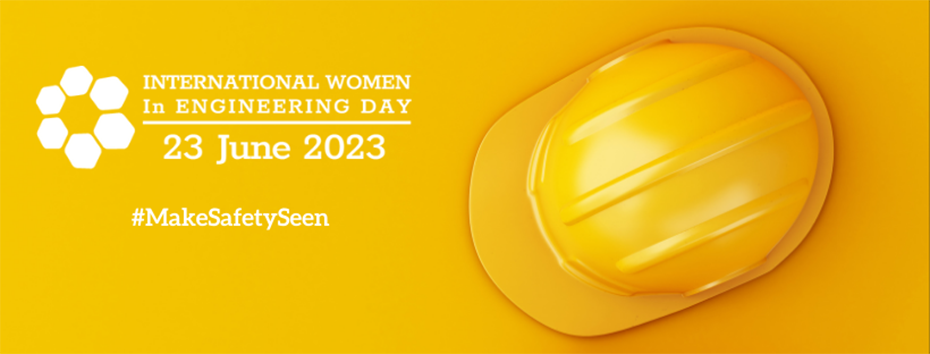
This year’s theme for International Women in Engineering Day (INWED), Make Safety Seen, has been inspired by the campaign’s roots. Launched ten years ago by the Women’s Engineering Society (WES), a former secretary and subsequent president of the society, Dame Caroline Haslett, is renowned, amongst other things, for her work improving electrical safety in the home. Specifically, she is credited with helping to develop three-pin fused plugs and shuttered sockets, designs still used in Britain today.[1]
Quick Links
- The Extraordinary Life of Dame Caroline Haslett
- Dame Caroline Haslett’s Lasting Legacy
- INWED Wants Women Improving Safety To Be Seen
- Further Information
The Extraordinary Life of Dame Caroline Haslett

Born to Caroline Sarah Haslett and Robert Haslett, a railway signal fitter and cooperative movement activist, on the 17th August 1895 in Worth, Sussex, (now part of Crawley in West Sussex, England), Caroline Haslett began her education in Haywards Heath. She subsequently enrolled on a business secretarial course in London at which time she also joined the Suffragette movement. Initially finding work at Cochran Boiler Company as a clerk, a dissatisfied Haslett soon asked to be transferred to the shop floor in order to learn the technical aspects of engineering. During World War I her wish was granted. In addition to running the London office, Haslett was transferred to the company workshop in Annan, Dumfriesshire in Scotland, where she undertook a basic apprenticeship and was trained in the manufacture of boilers. Caroline Haslett loved this work stating that:
“As soon as I got into the works, I knew this was my world”
– Caroline Haslett, The Doors of Opportunity[2]
A member of both the Suffragette movement and Women’s Social and Political Union, in 1918 Haslett’s two passions fused and she spent the rest of her life as a pioneer for women in the electrical and professional world.
In 1919 Caroline Haslett responded to an advert for a:
“Lady with some experience in engineering works as organising secretary for a woman’s engineering society.”[3]
To the dismay of her employers, Haslett left Cochran Boiler Company to become the first secretary of the Women’s Engineering Society and the founding editor of The Woman Engineer magazine which she worked on until 1932. In 1920 she helped form an engineering firm for women, Atalanta Ltd; while in 1924 she co-founded and became the inaugural director of the Electrical Association for Women (EAW), as well as the first editor of the EAW’s journal The Electrical Age. The EAW was a feminist and educational organisation focused on emancipating women from the drudgery of housework by introducing the use of electricity in working- and middle-class homes. Haslett explained:
“Way is being made by electricity for a higher order of women – women set free from drudgery, who have time for reflection; for self-respect. We are coming to an age when the spiritual and higher state of life will have freer development, and this is only possible when women are liberated from soul-destroying drudgery ... I want [every woman] to have leisure to acquaint herself more profoundly with the topics of the day.”[4]
Caroline Haslett believed that all women should benefit from engineering, not just those who pursue it as a career. As such, she continued to serve as director of the EAW and editor of The Electrical Age, as well as six editions of the EAW’s Electrical Handbook for Women, until her health began to decline in 1956. At the time of her retirement from the EAW, the association had 14 000 members across 160 branches.
During the second world war, the Institute of Electrical Engineers commissioned a twenty-person committee to determine the requirements for electrical installations in post-war Britain as part of the Post-War Building Studies scheme. Haslett was the only safety expert and the only woman on the panel. She was instrumental in the development of the BS 1363 standard for fused plugs and shuttered socket outlets, published in 1947.

One of the criteria Haslett and the committee focused on was ensuring the safety of young children. In their report, they stated that:
“To ensure the safety of young children it is of considerable importance that the contacts of the socket-outlet should be protected by shutters or other like means, or by the inherent design of the outlet.”[5]
They went on to advise that the revised design of plugs and sockets should be flush fitting, switchless, offer bottom cable entry, have a contact design, be easy to withdraw, include a fuse, and be impossible to insert incorrectly. The committee also detailed terminal requirements and recommended ring circuit systems.[6] This led to the publication of the BS 1363 standard in 1947. It remains in use across Britain today, as do the three-pin fused plugs and shuttered sockets recommended by Haslett and the committee.[7]
In addition to championing the use of electricity in the home and advancing domestic electrical safety, Haslett, in the words of her friend Margaret Partridge, an electrical engineer and WES president, was:
“[…] a member of the council of the British Institute of Management 1946-54, of the Industrial Welfare Society, of the National Industrial Alliance, of the Administrative Staff College, and of King’s College of Household and Social Science; a governor of the London School of Economics, of Queen Elizabeth College, and of Bedford College for Women; a member of the Central Committee on Women’s Training and Employment; a member of council and vice-president of the Royal Society of Arts 1941-55; and president of the British Federation of Business and Professional Women. She was a member of the Women’s Consultative Committee and the Advisory Council of the Appointments Department, Ministry of Labour; a member of the Correspondence Committee on Women’s Work of the International Labour Office; and the first woman to be made a Companion of the Institution of Electrical Engineers (IEE).”
From 1930, Haslett represented Britain at power conferences. Unsurprisingly, she was often one of a minority of female delegates and was the only woman representative at the 1930 World Power Conference in Berlin. She also took a leading role in conferences organised for women in Germany by the British and American authorities and represented the UK government on business missions in the USA, Canada, and Scandinavia. She was appointed a member of the British Electricity Authority (BEA) in 1947, which was in Margaret Partridge’s opinion Haslett’s greatest achievement. Following this, in 1948 Haslett became Vice-President of the British Electrical Development Association before being appointed as the first female chairperson in 1953-54.[8]
In 1956, Dame Caroline Haslett was forced to retire to her sister’s home in Bungay, Suffolk, due to ill health. On the 4th January 1957, aged 61, Caroline Haslett sadly died from coronary thrombosis. She was survived by her sister and biographer, Mrs Rosalind Lillian Messenger. In her will, Haslett specified that she wanted to be cremated by electricity; an act it is believed the City of London Crematorium duly performed.
Dame Caroline Haslett’s Lasting Legacy

Dame Caroline Haslett’s achievements are not confined to history. As previously highlighted, her work with the 1942 IEE committee on improving electrical safety in the home led to the implication of the BS 1363 standard for three-pin fused plugs and shuttered sockets. This regulation is still in use today; which means that every individual in Britain continues to be protected by Dame Caroline Haslett’s legacy!
In acknowledgement of her influential and multifaceted career, Caroline Haslett received many honours and awards both during her lifetime and posthumously. Most notably Caroline Haslett was awarded an OBE in 1931 for services to women and was made a Dame (DBE) in 1947 recognising her work for the Board of Trade and the Ministry of Labour. [9]
As a notable figure, she was included in a series of portraits commissioned by the War Artists Advisory Committee and captured by renowned French-Scottish lithographer and painter, Ethel Léontine Gabain. The drawing, made in 1945, can be seen in the Imperial War Museum. Then, in 1949, the British Electricity Authority (BEA) launched the Dame Caroline Haslett Collier ship, so named to commemorate Dame Caroline Haslett’s admission as the BEA’s first female member.[10]
Haslett also gives her name to a street in Crawley, West Sussex, and a primary school in Milton Keynes, Buckinghamshire.[11] The Women’s Engineering Society has named a lecture series in her honour; at the 2022 Caroline Haslett Lecture, Anne Locker of the IET Library and Archives gave a presentation detailing Haslett’s remarkable life and legacy. Locker suggests that despite being a professional engineer, Haslett’s greatest legacy is as a networker, administrator, bureaucrat, and civil servant, who “[made] engineering happen”. She argues, convincingly, that without Haslett:
“[…] the Women’s Engineering Society would not have flourished, the advent of electricity in the home would have been curtailed, and the campaign for women to enter the professions and to be paid equal wages for equal work would have been severely diminished.”[12]
INWED Wants Women Improving Safety To Be Seen

Taking inspiration from their first secretary Caroline Haslett, the theme of WES’ 2023 International Women in Engineering Day is #MakeSafetySeen. They have recruited Dame Dawn Childs DBE FREng, current CEO of Pure Data Centres Group and previously the UK Change Director for National Grid’s gas and electricity transmission businesses, for their annual INWED Webinar.[13]
In addition to this, the Women’s Engineering Society has focused this year’s WE50 awards on:
“[Celebrating] the women engineers who are engaged in safety and security and who #MakeSafetySeen […] Following in the footsteps of our first Secretary, Dame Caroline Haslett, who invented the three-pin safety plug to protect children from electric shocks, the WE50 winners will be women who are protecting the public through their work, often seen and unseen.”[14]
Discover This Year’s WE50 Winners
Further Information
Further information about International Women in Engineering Day can be found here. Additionally, to learn more about the Women’s Engineering Society and its 104-year history, please follow this link.
International Women in Engineering Day (INWED)
Women’s Engineering Society (WES)
Check out our past International Women in Engineering Day and International Women’s Day blogs below.
Hertha Ayrton, the First Female Member of the IET
Lillian Baumbach, the USA’s First Female Master Plumber
International Women in Engineering Day 2022: #ImagineTheFuture
Embracing Equity is Essential for the Survival of the Trades
At PASS Ltd we offer an array of electrical, high voltage, thermal, ultrasound, and pressure training courses to help you ensure correct and safe working practices. Please browse our prospectus of courses here.
Additionally, we offer an extensive range of test equipment, such as PAT testers and socket testers, designed to improve home and workplace safety. Our eclectic offering of instruments can be purchased through our website.
Finally, to keep your equipment functional, safe, and within the manufacturer’s specifications, we offer calibration and repair services.
View Our Calibration & Repair Scope
For help or advice regarding any of our products, training courses, or calibration services, please don’t hesitate to contact our team on 01642 931 329 or via our online form.
Footnotes
[1] Dave Hathaway, ‘A well-deserved plug for Dame Caroline Haslett, who followed her electric dreams’, The Guardian, last accessed 05 June 2023 and Wikipedia, Caroline Haslett, last accessed 05 June 2023
[2] Anne Locker, ‘Caroline Haslett History’, Caroline Haslett Lecture 2022, last accessed 05 June 2023
[3] Nina C Baker, ‘72: Caroline Haslett’, Magnificent Women, last accessed 05 June 2023
[4] Wikipedia, Caroline Haslett
[5] Wikipedia, Caroline Haslett
[6] Wikipedia, AC power plugs and sockets: British and related types, last accessed 05 June 2023
[7] Dave Hathaway, ‘A well-deserved plug for Dame Caroline Haslett, who followed her electric dreams’
[8] Wikipedia, Caroline Haslett
[9] Wikipedia, Caroline Haslett
[10] Wikipedia, Caroline Haslett
[11] Nina C Baker, ‘72: Caroline Haslett’
[12] Anne Locker, ‘Caroline Haslett History’
[13] International Women in Engineering Day, INWED23 Webinar, last accessed 05 June 2023
[14] Women’s Engineering Society, The Top 50 Women in Engineering #WE50, last accessed 05 June 2023


